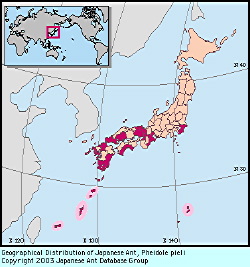
|
species
|
Pheidole pieli
|
 |
Japanese Name
|
Hime-oozu-ari
|
Original Reference
|
|
Santschi, F. (1925) Contribution la faune myrmcologique de la Chine. Bulletin de la Socit Vaudoise des Sciences Naturelles 56: 81-96.
|
Description
|
|
Total length of body around 3 mm in soldiers, around 1.5 mm in workers. The smallest known Japanese Pheidole species (head width 1.04 mm or less in soldiers, 0.45 mm or less in workers). Body color yellow to yellowish-brown. In soldiers: gular dentition with 3 distinct median projections; head almost as long as wide; pro- and mesonota forming a single convexity. In workers: posterior portion of head flat, with weakly concave posterior margin and no occipital carina; gular dentition undeveloped; median longitudinal carina absent on clypeus; lateral portion of pronotum smooth and shining, without sculpturing; the remainder as in soldier.
|
Remarks
|
|
Sculpturing on the head of workers from the Nansei Islands is less-developed and the propodeal spines smaller than in material from mainlsand Japan. Found in rather moist woodland habitats, nesting in decaying wood and in the soil, often under stones. Colonies include at most around 2,000 individuals. Soldiers may be utilized for the storage of liquid food in their gasters, in addition to their other functions.
|
|

Distribution
|
|
Honshu (southern part), Shikoku, Kyushu, Nansei Is; Mainland China, Korean Peninsula.
|
|
Editor
|
|
Original text by Kazuo Ogata and Seiki Yamane. English translation by Kazuo Ogata, edited by Robert W. Taylor.
|
|